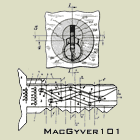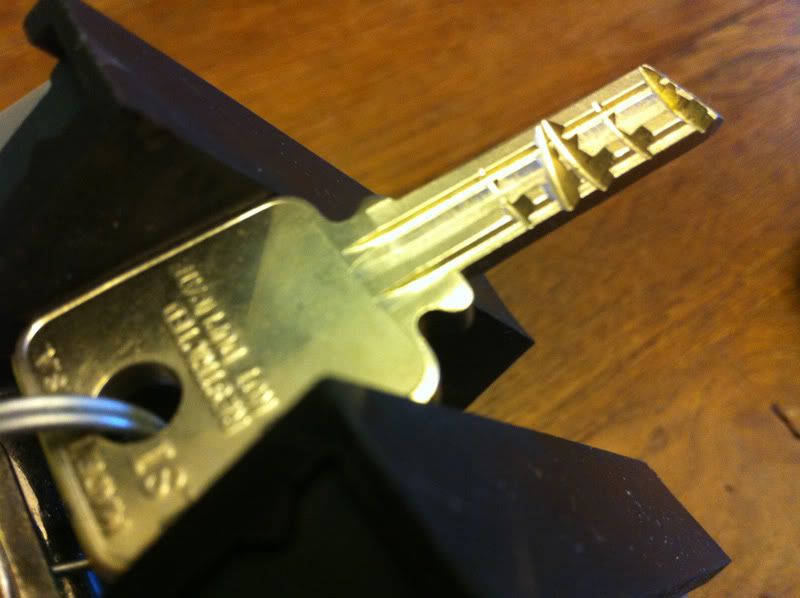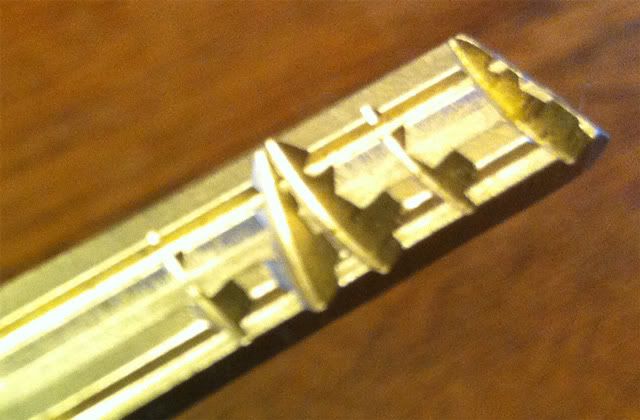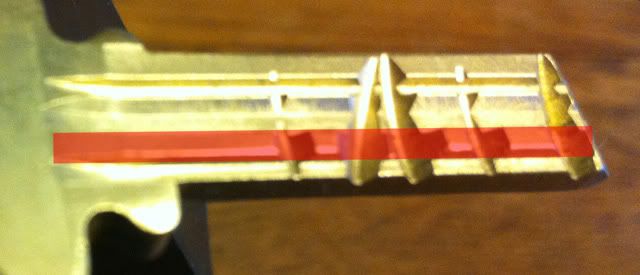|
Information about locks themselves. Questions, tips and lock diagram information should be posted here.
 by Squelchtone » 13 Apr 2011 11:49 by Squelchtone » 13 Apr 2011 11:49
-

Squelchtone
- Site Admin
-
- Posts: 11325
- Joined: 11 May 2006 0:41
- Location: right behind you.
 by MacGyver101 » 13 Apr 2011 13:42 by MacGyver101 » 13 Apr 2011 13:42
I have one as well, and agree with squelchtone: cool design. Their main market is camlocks for slot machines, video gaming, etc., where they wanted a key design that was much more robust and less likely to break than Medeco's traditional camlock keys. The keys certainly feel substantial and, like most dimple locks, appear that they would "wear" much better while bouncing around on a keychain than traditional pin-tumbler keys. Here's the patent on the Duracam keys. I had assumed that the key would feel awkward to rotate (it's not centered on the plug, and rotates through an "arc" when you turn it), but it actually feels quite smooth. They also make a Duracam II with a removeable core; here's the patent drawings for that design.
-

MacGyver101
- Moderator Emeritus
-
- Posts: 1560
- Joined: 21 Jun 2006 14:40
- Location: Toronto, Canada
 by Evan » 13 Apr 2011 15:20 by Evan » 13 Apr 2011 15:20
Those Duracam locks look nice as far as not bending or breaking the keys...
Too bad they aren't used on vending machines...
Any idea on how much more they cost compared to regular Medeco cam locks ?
Are the keys able to be produced in the field or is this one of those Medeco factory only type restricted deals ?
~~ Evan
-
Evan
-
- Posts: 1489
- Joined: 5 Apr 2010 17:09
- Location: Rhode Island
 by MacGyver101 » 13 Apr 2011 17:54 by MacGyver101 » 13 Apr 2011 17:54
Evan wrote:Are the keys able to be produced in the field or is this one of those Medeco factory only type restricted deals?
Based on the keys I have, it looks like the cuts are made by pushing the blank into a circular cutting wheel -- so, in theory, it could be easily done in the field if you had the right jig and cutting wheel... but, I have no idea if, in practice, they actually sell such a thing that would allow you to adapt a standard key machine. (Or the blanks, for that matter.)
-

MacGyver101
- Moderator Emeritus
-
- Posts: 1560
- Joined: 21 Jun 2006 14:40
- Location: Toronto, Canada
 by MacGnG1 » 13 Apr 2011 21:59 by MacGnG1 » 13 Apr 2011 21:59
LockSmithArmy has a video on youtube: http://www.youtube.com/watch?v=qPjCJK-Gj_wthese are really interesting, they were designed for slot machines or other applications where there is a lot of key usage so the keys dont break off. i'd be interested in gettin one too. i got a toolbox that needs a new cam. Nibbler: The poop-eradication is but one aspect of your importance.
-
MacGnG1
- Supporter

-
- Posts: 1362
- Joined: 9 Apr 2008 22:14
- Location: Know Where, MD, USA
-
 by Evan » 14 Apr 2011 19:47 by Evan » 14 Apr 2011 19:47
MacGyver101 wrote:Evan wrote:Are the keys able to be produced in the field or is this one of those Medeco factory only type restricted deals?
Based on the keys I have, it looks like the cuts are made by pushing the blank into a circular cutting wheel -- so, in theory, it could be easily done in the field if you had the right jig and cutting wheel... but, I have no idea if, in practice, they actually sell such a thing that would allow you to adapt a standard key machine. (Or the blanks, for that matter.)
Never having seen one of these keys other than in a few pictures posted around by squelchtone and a google search, I would think that a special machine would be needed to create the angled cuts... A normal key machine creates the bittings on the key by being capable of moving on two axes: back-and-forth (x-dimension) for the spacing of the cuts AND in-and-out (y-dimension) plunging into the fixed milling blade for the depth of the cut... This exposes the top edge of the key blank to be milled by the machine... Manual machines should only be operated along one axial dimension at a time, automated CNC key machines can operate along both axes at the same time... The Medeco Duracam keys are milled on the side of the blank rather than the top edge like most keys... So moving the key into the blade would be a very complicated process to do in order to mill the bittings onto the blank key in the unusual position with a normal key machine... The most efficient design method to use to produce a machine to mill such keys would be a miniature version of a sliding miter saw... (Which would be unlike any key machine presently in use) Where you can set the angles of the cut by locking the armature supporting the cutting blade and motor into a detent before plunging it into/sliding it across the key... You would then be able to more precisely control the spacing (including fore and aft) of the bittings with a less complex clamp/vise since it need not swivel during operation left and right of center... I am not sure whether it would be better to control the depth of cut by moving the clamped key blank and vise up and down or by moving the blade/motor assembly up and down relative to the clamp/vise... It is the difference between trying to build a picture frame using a table saw versus using a power miter (chop) saw... Sure making the angled cuts is possible using a table saw, but you need complicated guides and material clamp down jigs to make such cuts on a table saw... ~~ Evan
-
Evan
-
- Posts: 1489
- Joined: 5 Apr 2010 17:09
- Location: Rhode Island
 by MacGyver101 » 14 Apr 2011 22:01 by MacGyver101 » 14 Apr 2011 22:01
Evan wrote:A normal key machine creates the bittings on the key by being capable of moving on two axes . . .
True. I agree with the mitre saw idea. I was thinking, though, more of a key machine suitable for cutting regular Medeco keys: the need for depth, spacing and angles are the same -- it's just that the key's cut on its side, instead of its edge. I may be thinking of it incorrectly, but I think you'd just need an arrangement with a jig, allowing the key to sit on top of the jaws (rather than clamped into them) on a regular Medeco key machine?
-

MacGyver101
- Moderator Emeritus
-
- Posts: 1560
- Joined: 21 Jun 2006 14:40
- Location: Toronto, Canada
 by lockinabox » 15 Apr 2011 9:46 by lockinabox » 15 Apr 2011 9:46
Evan wrote:I would think that a special machine would be needed to create the angled cuts...
A normal key machine creates the bittings on the key by being capable of moving on two axes: back-and-forth (x-dimension) for the spacing of the cuts AND in-and-out (y-dimension) plunging into the fixed milling blade for the depth of the cut... This exposes the top edge of the key blank to be milled by the machine... Manual machines should only be operated along one axial dimension at a time, automated CNC key machines can operate along both axes at the same time...
The Medeco Duracam keys are milled on the side of the blank rather than the top edge like most keys... So moving the key into the blade would be a very complicated process to do in order to mill the bittings onto the blank key in the unusual position with a normal key machine...
Wrong. MacGyver101 wrote:I was thinking, though, more of a key machine suitable for cutting regular Medeco keys: the need for depth, spacing and angles are the same -- it's just that the key's cut on its side, instead of its edge. I may be thinking of it incorrectly, but I think you'd just need an arrangement with a jig, allowing the key to sit on top of the jaws (rather than clamped into them) on a regular Medeco key machine?
Right. No special machine is needed. Only difference between them is the orientation of the key when you're cutting it. Theoretically, you can cut a standard medeco key to the correct depths and angles, cut 1/8"(the thickness of the Duracam key) off the top of the key blade and use it to open the lock.
-
lockinabox
-
- Posts: 206
- Joined: 11 Sep 2009 14:52
- Location: Texas
 by MacGyver101 » 15 Apr 2011 12:34 by MacGyver101 » 15 Apr 2011 12:34
lockinabox wrote:Theoretically, you can cut a standard medeco key to the correct depths and angles, cut 1/8"(the thickness of the Duracam key) off the top of the key blade and use it to open the lock.
Hrm... interesting point. Given that there's no milling under the pins (at least, on the couple of keyways I've seen), it does do away with the key control somewhat: a thin strip of just about anything could be cut and slid into the right-hand side of the keyway, in lieu of a proper key.
-

MacGyver101
- Moderator Emeritus
-
- Posts: 1560
- Joined: 21 Jun 2006 14:40
- Location: Toronto, Canada
 by Evan » 15 Apr 2011 16:59 by Evan » 15 Apr 2011 16:59
lockinabox wrote:Wrong.
No special machine is needed. Only difference between them is the orientation of the key when you're cutting it.
Theoretically, you can cut a standard medeco key to the correct depths and angles, cut 1/8"(the thickness of the Duracam key) off the top of the key blade and use it to open the lock.
Well, I respectfully disagree... The width of the side of the key is MUCH wider an area to machine than what normal key machines are designed to cut... More than a special jaw would be required... If you have pictures or a video of the process of originating a Duracam key on a standard key machine I will stand corrected... Short of that we will just have to agree to disagree... Interesting idea on the thin slice of the key -- maybe you should try that out and report back... ~~ Evan
-
Evan
-
- Posts: 1489
- Joined: 5 Apr 2010 17:09
- Location: Rhode Island
 by dls » 15 Apr 2011 17:12 by dls » 15 Apr 2011 17:12
I wonder if a machine like a silca matrix could cut one of these, ts essentially a dimple key
when you look at it only the dimples arent round.
The machine is capable of operating in 3 axis so using the correct cutter it should be no problem.
It would also be no problem to mill out another blank to pass the keyway in the lock with the same machine.
When picking starts to hurt take your finger out
-
dls
-
- Posts: 283
- Joined: 10 Mar 2011 16:57
- Location: ireland
 by MacGyver101 » 16 Apr 2011 7:21 by MacGyver101 » 16 Apr 2011 7:21
Evan wrote:The width of the side of the key is MUCH wider an area to machine than what normal key machines are designed to cut...
Ah, true. What's not immediately obvious from photos, though, is that the cuts on the key aren't the same depth all the way across:  Something like your sliding mitre saw idea would be required, if the cuts had to be an even depth all the way across. What I'd tried to explain earlier (and likely not as clearly as I'd hoped) is that the cuts appear to just be made with a single press against a circular cutting wheel -- as the depth is considerably less on the left-hand side of the cut:  The reason for this, of course, is that only a small portion of the width of the cut is actually used; even though the key is far wider than normal, the pins are still a standard width. They only intersect the key along a narrow strip (which I've coloured in red):  ...and, as a result, the depth of the cut doesn't matter to the left of where the pins contact the key. (Again, this is hard to see from most photos: it's much easier when you're holding the key and able to stare into the lock at the same time.) 
-

MacGyver101
- Moderator Emeritus
-
- Posts: 1560
- Joined: 21 Jun 2006 14:40
- Location: Toronto, Canada
 by dls » 16 Apr 2011 7:41 by dls » 16 Apr 2011 7:41
looking at the key there i think the matrix machine would be able to cut it i would also say its easy
enough to do by hand with a triangular file as the cut could be the same depth across the bit and
depth and angle seem to be the critical factors. I have cut lots of medico 3 pin keys for the cs401
with a file its no harder than any other key
When picking starts to hurt take your finger out
-
dls
-
- Posts: 283
- Joined: 10 Mar 2011 16:57
- Location: ireland
Return to Locks
Who is online
Users browsing this forum: No registered users and 5 guests
|
